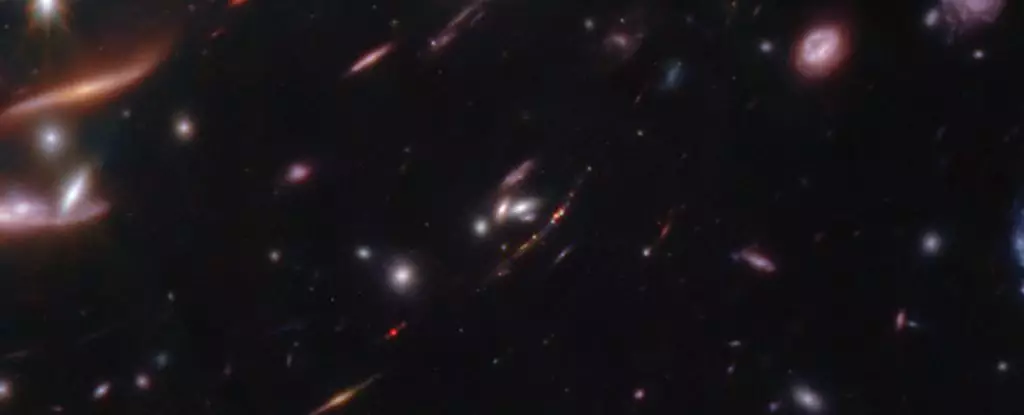In the grand expanse of the universe, a remarkable discovery has pulled the veil back on a formative era of cosmic history: the birth of galaxies. Blushing with the vibrancy of newly formed stars, a galaxy named “Firefly Sparkle” presents an extraordinary insight into the state of our Milky Way when it was just a fledgling entity, a mere 600 million years after the Big Bang. Thanks to groundbreaking observational techniques, particularly those wielded by the James Webb Space Telescope (JWST), astronomers can now explore this distant stellar nursery, unveiling a complex tapestry woven in the early cosmos.
Firefly Sparkle is positioned at an astonishing distance of 13.2 billion light-years from Earth, making its observation a feat that tugs at the strings of both curiosity and technology. The galaxy, characterized by intense star formation, serves as a prime candidate to study the mechanisms at play when the universe began to take shape. Its ethereal glow reflects the conditions of the universe during the Cosmic Dawn—a crucial epoch when matter began to coalesce into the stars and galaxies we know today.
The Cosmic Dawn, often described as a period of astronomical upheaval, is the epoch that holds unparalleled significance for cosmologists and astrophysicists alike. It represents the explosive era when the universe evolved from a chaotic soup of particles into coherent structures, such as galaxies. However, observing this epoch presents challenges akin to peering through a dense fog—ever elusive, objects from this time appear only as faint smudges of light, rendering them difficult to differentiate with existing astronomical tools.
The triumphs of the JWST, combined with the phenomenon of gravitational lensing, have turned these challenges into opportunities. Gravitational lensing occurs when a massive celestial object, like a galaxy cluster, warps the fabric of space-time around it. As light from more distant objects travels through this warped space, it becomes distorted, magnified, and sometimes replicated. This natural magnifying effect allows astronomers to dissect elongated arcs of light, restoring clarity to what would otherwise remain obscured.
Within this marvel of cosmic optics, Firefly Sparkle emerges almost as a galactic sculpture. Situated behind a colossal foreground galaxy cluster, its light has traversed an incredible 5.3 billion years to reach us. This arrangement of cosmic elements made it an ideal subject for investigation, as the gravitational field of the foreground cluster acts like a cosmic lens, illuminating the intricate star-forming processes at play.
The reconstruction of Firefly Sparkle’s light reveals a dynamic landscape, where clusters of star formation gleam against a backdrop of diffuse starlight. Astrophysicists, such as Kartheik Iyer from Columbia University, assert that these individual star clusters reveal the ongoing birth of stars, suggesting a complex evolutionary history. Not only does this reveal that star formation is neither simultaneous nor uniform, but it also hints at different evolutionary phases playing out across clusters, enriching our understanding of galactic development.
Insights into Galactic Growth and Interactions
The discovery of Firefly Sparkle not only sheds light on its own developmental intricacies but also offers new perspectives on galactic evolution as a whole. The mass of Firefly Sparkle is consistent with that of a nascent Milky Way, highlighting striking similarities in the formative processes at work during different epochs. In fact, the observational evidence suggests that not all galaxies exist in isolation; two nearby galaxies, located at 6,500 and 42,000 light-years away, hint at the possibility of gravitational interactions. This proximity indicates that these galaxies may be caught up in a gravitational waltz, undergoing potential merger events that could be critical for understanding the way galaxies amalgamate over time.
Such interactions are not just academic concepts; they echo the evolutionary history of our own Milky Way, which has grown significantly through the absorption of smaller galaxies—a process known as galactic cannibalism. Yoshihisa Asada from Kyoto University emphasizes that these mergers are predicted to be foundational to early galaxy formation, and the observations of Firefly Sparkle substantiate this hypothesis.
As we dive deeper into the cosmos, the insights garnered from Firefly Sparkle promise to illuminate not only our understanding of galaxy formation but also the wider narrative of cosmic evolution. Maruša Bradač from the University of Ljubljana predicts that this discovery is merely the beginning. Just as microscopes unveiled the intricacies of the microscopic world, the unparalleled resolution of the JWST, coupled with the magnification effects of gravitational lensing, promises to reveal previously unseen structures within galaxies.
The Firefly Sparkle stands not merely as a distant astronomical object but as a critical piece in the puzzle of cosmic history. Its discovery enriches our understanding of galaxy formation processes and invites us to explore the complexities of the universe, holding a mirror to our own origins amid the stars.


Leave a Reply